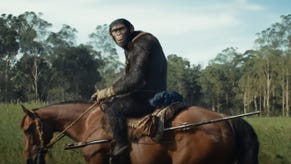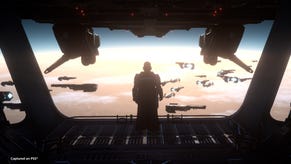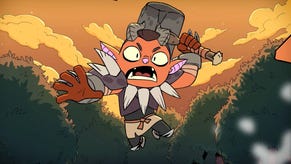Kinect's Panzer Dragoon - TGS shows off Project Draco
Dragons, Kinect, Tokyo Game Show 2011: these three elements combined to bring you Brenna Hillier's report from Japan on Kinect's continuing mission to court the core.
Mounted on a fierce dragon, soaring through landscapes dotted with island chains, jungles, and ravines? Project Draco sounds fantastic.
"It's not fantasy," director Yukio Futatsugi stressed.
"It's sci-fi. It's another planet. And there's dragons living there."
The "dragon" is steered by shifting your centre of gravity in front of the Kinect sensor - leaning left and right, in other words - but the spindly yet massive beasts have a mind of their own. The player's navigational capacities are reduced to dodging incoming fire and obstacles in this on-rails shooter.
Players have two firing modes - a light but fast homing laser weapon fired by the player's avatar, and a weightier, slower burst emitted by the dragon itself - such as fireballs. Both are triggered with short jerks of the right or left hand, while quickly dropping both palms towards the floor lets loose a super attack - once a damage gauge has been filled.
Aiming the cursor and firing bears a strong resemblance to Child of Eden; not coincidentally.
"Child of Eden came out first. A lot of people played that game. I thought it would be a bad idea if people who played that game are presented with a completely different control scheme," Futatsugi said, answering a question from Eurogamer.
"It's unfair to be like, 'So you like shooters? Well, you have to learn a different control scheme now.' I like the Child of Eden control scheme. It's good. There's nothing wrong with it.
"Since we have conceptual similarities, as a result we came up with a pretty similar scheme, and we decided not to change that.
"Every game that followed Mario tried to do the same thing basically, because you don't want to confuse the user. It's a 3D on-rails shooter on Kinect, so it's natural for the control scheme to be similar.
"We did have our own control scheme before we knew exactly what Eden was going to be like. What we did after it came out was we tuned it so that people who did the Eden gesture would also be able to play our game as well.
"We had a bigger gesture for our shots," the director explained, flipping his hand and arm through 45 degrees from behind his ear, and then demonstrating Eden's smaller wrist-flick gesture, now integrated into Project Draco.
"I anticipated that there would be a lot of Eden players who would come to play our game and try to fire like the other game. We made sure that they could play our game as well.
"It's hard to make a high difficulty game on Kinect. If you go over the threshold it becomes impossible. It's unfair. On the game pad, it's really scalable, but on Kinect, if it's too difficult it's impossible and if it's too easy you fall asleep."
"It's not like [Child of Eden creator Tetsuya] Mizuguchi and I are completely foreign to each other. The people who made Child of Eden made Rez, and those people were Panzer Dragoon team guys."
That's another game Project Draco immediately invokes, both by its subject matter and its shared developer - the classic Sega property, Panzer Dragoon. But Grounding didn't set out to make another Panzer game, drawing inspiration instead from the controller tech.
"When you try to make a shooter on Kinect, you have to think about movement," Futatsugi said, through a Microsoft interpreter.
"I don't think there is a very good paradigm in terms of controlling movement back and forth, left and right. So I thought, 'OK, on Kinect maybe we'll just make it on rails, so the situation comes to you, and the player has to deal with it by dodging it - by shifting their weight, so they don't have to move around their living room.'"
Unrestricted
Futatsugi doesn't feel restricted by Kinect, likening the resulting game design paradigm to arcade shooters.
"So then I thought, 'OK, we're on an on-rails shooter - what are we going to be in the game? I thought, you could be a jet fighter, but you don't really [lean to steer in] an aeroplane, right?
"I thought, 'What do we do? What do you control by shifting your weight? Rideable animals. And then, rideable animals, well - dragon, yay!"
The dragons of Project Draco are not the smooth, lizard-like creatures of western myth or the trailing cloud serpents of Japan, but long-limbed, clearly alien creatures, their wings and claws hinting oddly at a spinal hub which looks somehow wrong, and therefore, given the fiction, absolutely right.
There are at least five of these creatures to befriend and train, and a layer of light RPG elements lends itself to obsessive attention to each and every one.
While completing missions always provides XP for your primary skills, only the highest ratings award the player with rare foods for unlocking and powering up the range of over 150 draconic abilities available.
"You don't have to unlock every single skill in order to finish the game," the director assured us.
"You learn new skills fairly quickly. We're still balancing this stuff so this could change, but we're thinking every one or two quests you learn a new skill. You get rewarded frequently; it's not like you have to sit through this exercise in time."
Moreover, if you're really keen to catch 'em all, you can enlist a mate.
"In one single-player campaign play through you might get - just an example - maybe 50 skills," Futatsugi added.
"But then, the more difficult to get, rare skills, you can unlock by playing the multiplayer co-op online. So maybe if you work with your friends it will be easier to unlock the more difficult skills.
"Using these different types of aspects, we make sure that it's not like a grind."
It's not that the game is incredibly difficult, but it does offer a challenge to those keen to acquire all the rarities, even with plenty of practice under the belts.
"I got an A," the demonstrator grumbled quietly, seeming more satisfied with his S-rating on a later section.
"It's hard to make a high difficulty game on Kinect," Fitatsugi mourned.
"If you go over the threshold it becomes impossible. It's unfair. On the game pad, it's really scalable, but on Kinect, if it's too difficult it's impossible and if it's too easy you fall asleep.
"So that's why we added the strategic level of being able to choose your skill for the mission. If you choose the right skill, it's fairly easy, if you choose the wrong skill, it gets difficult all of a sudden."
Difficulty spikes are also found in the game's bosses. Each of the planets the player will explore offers multiple quests, one boss, and one mini-boss. We're given a look at one such mini-boss, a fierce encounter with two huge enemy dragons, involving plenty of dodging and weaving as well as frantic shooting.
I'm somewhat envious of the demonstrator, as his intent focus on accuracy belies the meditative calm of soaring through the gorgeous landscapes of Project Draco, uninterrupted by the usual Kinect-exclusive flailing aerobics.
"You don't do any jumping up and down or anything like that - we were thinking of living rooms," the demonstrator explained.
"It's not that intense. I've been demonstrating this game to people all day and I'm not even breaking a sweat."
Project Draco ships for Kinect in 2012.








.png?width=291&height=164&fit=crop&quality=80&format=jpg&auto=webp)


